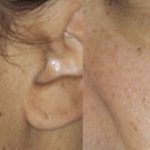
Female Pattern Hair Loss
Female pattern hair loss is the most common condition that we see and treat in women. We can ensure well over a 60% chance of hair re-growth for most women treated for female pattern hair loss, and that’s just re-growth! Many of the rest will experience stabilization and slowing of the hair loss. You can see the success of many of our patients’ treatment courses by viewing our female pattern hair loss patient photo-scans. Thankfully there are effective treatments available for Female Pattern Hair Loss. Please note that results may vary and are not guaranteed.
Female Pattern Hair Loss (Androgenic Alopecia)
Whilst genetic thinning and baldness is more common in men, tens of thousands of women in Canada suffer from female pattern hair loss. However, it affects the genders differently. While men experience ‘vertex balding’ and/or ‘receding frontal hairline’, women with female pattern hair loss generally experience ‘diffused thinning’, generally throughout the top of the head or crown.
Female pattern hair loss usually begins at around the age of 30 and even as early as in the 20s or earlier. The thinning hair usually becomes noticeable around age 40, and may be even more noticeable after menopause. By the age of 50, 50% of women will experience some degree of hair thinning from female pattern hair loss or another condition such as diffuse hair loss or telogen effluvium.

Female pattern hair loss is often an overall thinning – two hairs where five used to be, rather than a bald area on top of the head like men. Women sometimes have a receding hairline too. Temporary conditions such as pregnancy, medication, diet, or stress can cause hair thinning, but 70% of women who experience this condition can attribute it to Androgenetic Alopecia, or Female Pattern Hair Loss. The signs and symptoms of female pattern hair loss are general thinning of hair over the top of head and moderate loss of hair on the crown or hairline.
Within the follicles affected by female pattern hair loss, biologically active testosterone is converted by an enzyme into a much more potent hormone derivative called ‘Dihydrotestosterone’. It is this powerful hormone which inhibits the metabolism of the forming genetically pre-disposed hair cells, resulting in the gradual process of finer, weaker hairs, as the follicle continues to shrink. Eventually these hair follicles die, resulting in irreversible baldness. In women, it is far rarer for areas of true baldness to appear than in cases of Male Pattern Baldness, though hair thinning can become advanced around the top of the scalp, as shown in this diagram.
The thinning process experienced by female pattern hair loss
As you age, a combination of heredity, the effects of hormones and simply getting older cause certain hair follicles to get smaller and smaller. This prevents the hair from fulfilling its regular growth process. With female pattern hair loss, hair follicles gradually become smaller and the period of time in which the hair grows is reduced causing each hair to become finer and shorter with each hair growth cycle. It is common for women to notice their parting becoming wider or their ponytail becoming less dense as the first signs of hair loss appear.
Hormonal change and female hair loss
Hormonal changes are a common cause of hair loss in women, and can trigger female pattern hair loss. After pregnancy or discontinuation of birth control pills, many women experience hair thinning to varying degrees, usually on a temporary basis.
While a woman is pregnant, and hormonal changes are occurring, more hair follicles enter the growth phase than normal. About two to three months after childbirth, the normal hair cycle returns and many hairs re-enter the resting phase which causes excessive shedding to occur. When this happens, a woman will start to shed more hair than usual. As a result, she will usually notice large amounts of hair in her brush and bath. This is usually a temporary condition, and as hormone levels in the body return to pre-pregnancy levels after about six months, the excessive shedding normally ends. If the condition does not change after six months, a woman may be experiencing female pattern hair loss which was masked by childbirth.






